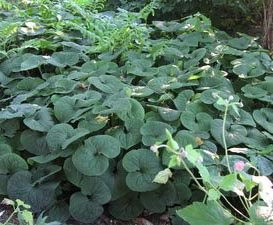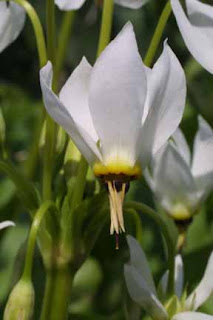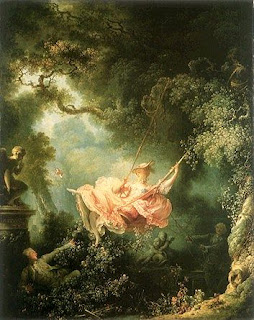Thursday, June 18, 2009
Wednesday, June 17, 2009
Plant Torture? Not Necessarily.
When the trellis work was installed, there was only one logical place for it so that's where it went. What was left for this garden of easy enough requests was a 30" wide bed between the fence and the blacktop in the blazing sun where the plow would push the snow in the winter months. Not so easy any more. These types of garden problems are what landscape designers excel at and when it really makes sense to consult with a professional.
Now three years later, the garden is thriving without irrigation or much care and it looks great. What's the secret? Plant choice. All of the plants chosen for this garden are drought tolerant, heat and sun loving, and tough as nails.
Here's the list:
Agastache x 'Black Adder'
Achillea 'Moonshine'
Baptisia austrailis
Iris germanica
Stachys byzantina
Sorghastrum nutans 'Sioux Blue'
Monday, June 15, 2009
Bloom Day--June 09
Sunday, June 14, 2009
The Garden of Lost Plants
I have one of many plants--with few multiples--I watch each grow, observe how big it really gets, what texture the foliage creates, if the bloom color and time is what I expect, and if the way I neglect them allows them to survive. I am always experimenting and have found winners and losers through this hodgepodge, totally unscientific process. My garden is not fenced or sprayed--I barely have time to pull the weeds. It is in a sub-urban environment with deer, rabbits, chipmunks, moles and a dog who has no respect for my efforts. Add kids and this is a similar environment to many of the landscape design projects I work on.

Another new one for '09 although I can't believe I haven't grown it before--Asarum canadensis
photo via Rush Creek Growers
I rotate plants in and out of empty spaces that are still in containers until they go to a new home and I've been known to dig something up and take it to a client--leaving a hole until a new orphan or test case takes its place. Some plants are so successful that I have too many--bearded Iris for one, Leucanthemum superbum 'Becky' is another. A couple of years ago I added some woodies for trial and structure. That has helped with design cohesion a bit.
Plants move in and out of my garden constantly. It is pretty and somewhat over the top and yes, there are things that stay for years. Sometimes they even survive the lawn guy's string trimmer.
Saturday, June 13, 2009
The Old Man
The old man's yard was unique to him. Two beautiful cherry trees heralded each spring's return, their lowest branches adorned with hanging baskets full of faded plastic blossoms. A garden of pinwheels stood at the foot of one. He had a sense of whimsy.
Tuesday, June 9, 2009
The Romantic Ideal
I think this is the most romantic image in a garden ever. Over exposed? Yes. But Fragonard's 'The Swing', pictured below, is the essence of romantic ideal. The young woman is joyful at being in love and in the garden...she is participating in her environment rather than just giving it a look or a walk through.
Has our concept of what is romantic in a garden changed since the 18th century? I don't think so. We still want the same human experience as the girl on the swing. What has changed is the availability of skilled labor to maintain the estate sized model it is based on and the philosophy that all natural resources are inexhaustible.
The romantic ideal might seem old fashioned, but it's a point of departure only limited by lack of imagination. There is the possibility of creating lush and jubilant outdoor spaces without being bound to a planting scheme or a single style. Romantic gardens beg human interaction--the discovery of a secret, a place for intimate conversation, or a solitary escape from the stresses of daily life. They are the sum of their parts...not just the framework for a floral display.
Sunday, June 7, 2009
Business as Unusual
 I consider myself to be fairly typical of landscape designers who are out there now. I have work, just not the amount or size of work I've had in the past. I am lucky to have loyal clients who come back again and again as well as some new ones who are willing to spend on new projects.
I consider myself to be fairly typical of landscape designers who are out there now. I have work, just not the amount or size of work I've had in the past. I am lucky to have loyal clients who come back again and again as well as some new ones who are willing to spend on new projects.Creativity is needed in our business so that it isn't business as usual, it is time for business to be unusual. We need to educate our clients about the intrinsic worth of what we provide and make it invaluable to them. We need to enhance their lives in every way possible--drawing them outside into the larger world so that our services become what they are willing to spend money on.
This summer is the 40th anniversary of Woodstock and I am reminded of the lyrics that very wise Joni Mitchell wrote all those years ago:
We are stardust
Billion year old carbon
We are golden
Caught in the devil's baragin
And we've got to get ourselves
Back to the garden
Friday, June 5, 2009
A rose by any other name...
About ten years ago I got all paranoid about using my real name as an identifier on the Landscape Design forum at GardenWeb. Miss Rumphius had been my favorite book to read to my son when he was small and I identified with her as a character--hence the screen name. Most people referred to me as Miss R. I stopped posting at Garden Web shortly after it was taken over by iVillage, but that's another story.
I decided to carry the Miss R moniker over to my blog for no real reason other than people already knew me by that name. Now I wonder if it might not be the best name for what I write about. Miss R's third third rule 'Do something to make the world more beautiful' still is, but the name...maybe not so much.
I have no idea what I'd call my blog other than Miss R, but I'd be interested in what everyone who reads here thinks. Leave a comment and let me know.
Wednesday, June 3, 2009
Mired In Tradition
What I already knew, and what three of the gardens I visited confirmed, is that on the east coast, those with the means to build a landscape of substance opt to emulate traditional English gardens. The old stone houses and barns that give Buck's County its lure form the backdrop for the gardens. Although one garden had a beautifully enhanced woodland, there was not one meadow in the acres and acres of mixed borders and mowed turfgrass that I saw. Planting styles differed within these gardens but the traditional garden design paradigm did not.
There were some beautiful vignettes and ideas within these classic schemes. One, at Willow Farm, had a grey/blue and burgundy palette juxtaposed with honey hued native stone that I particularly liked.
Monday, June 1, 2009
My Garden State--Basking Ridge
I have a fondness for old graveyards, and the Old Oak made my visit incredibly special. At lunchtime, I was the only living person there and the noise of traffic and the bustle of noontime activity in the village seemed distant, event though the church and cemetery are at a busy crossroad.
Standing next to it, this American native tree's trunk is more than 6' in diameter--its branches are supported by crutches and cables.
The raw power of the oak's presence combined with the remnants of 18th and 19th century lives lovingly carved into the headstones is hard to describe. For me, it was an emotionally charged experience full of reverence for nature and respect for those who had been.
Sunday, May 31, 2009
Arching Bells
I have used it in my garden as well in those of several clients. The deer don't eat it and it starts its show right after the alliums--to which it's related. The leaves, like alliums, aren't terribly attractive and can easily be hidden by careful planting design that allows N. siculum to punctuate shorter plants with more interesting foliage. The first time I saw it in a garden, its companion was Hosta 'Sum and Substance' and the combination stopped me in my tracks.
Saturday, May 30, 2009
Long ago I lived in Lille...France that is
Even though the photographs evoke the grey that, for me, is unique to northwest France, imagine how thrilled I was to find the work of Frank Lefebvre and his company Blue Nature. Primarily interior, there are outdoor pieces as well. Some designs are modern and clean lined while others are traditional flights of fancy.
Using petrified, reclaimed and untreated wood this company, based near Lille, crafts beautiful and evocative pieces that honor and respect the materials they are made from. Isn't this what the best garden design does also?
All photographs: BLEU NATURE – Sarl BN HOME Photographers : Didier Knoff and Gilles Piat
Wednesday, May 27, 2009
White
I know the idea is not new, but white has a symbolic power beyond the absence of color and I think it's appropriate for our times.

Photo via Vanderbilt.edu
Tuesday, May 26, 2009
Often way over my head
Anyway, when I was out for my early morning walk today I noticed a young, low branched Tuliptree (Liriodendron tulipifera) in bloom. An eastern native, it's not often I get to see these exotic flowers at eye level as the trees in my parts are tall, tall, tall and their blooms are usually 50-60-70 feet above my head.
Monday, May 25, 2009
Talking to Myself
I have in some way and in fits and starts kept a journal for years. There have been times when just the act of chronicling what ever was happening in my life has helped me sort it out. As a teenager they consisted of pages and pages of laments, descriptions of parental and personal drama, social slights and ad hoc adventures.
After graduating from art school I starting making illustrated journals in black bound sketchbooks and for years I kept them safely in a box to be looked at now and then. Ten years ago, all but one of these sketchbook journals were destroyed in a basement flood.

Studies for a series of landscape inspired brooches circa 1977
What wasn't destroyed were the two new types of journals I had been keeping. In dated composition books I kept a series of garden journals. My garden composition books were often carried with me to the nursery, library or bookstore. My first designed garden is in one. Although I have an extensive design education and years of experience, I am a self taught gardener. My garden journals contained sketches, ideas, bloom times, receipts, plant labels all types of information that I wanted to remember.

A page of one of my garden composition notebooks
In small sketchbooks I kept travel journals. Since I have always had to travel on the cheap, these journals became souvenirs of my adventures. I recorded descriptions of places and made collages of tickets, postcards and sketches. Ephemera was collected and the notebooks were created on the go. They were a record of where I had been in the world larger than my own backyard.

From a trip to London in 2001
In both of these new journals there were also tidbits of the old journals--personal notes and the occasional lament.
When I first started writing Miss R, I didn't realize that it would evolve into a new type of journal. The first year was stop and go, and I didn’t really pay much attention to the content or frequency. Now I realize that the content is really an extension of my years of writing about my life. No, I don't often write about personal drama, but I do definitely write about the way I feel about what I do. I also write about places I've been and plants I've seen and post drawings, designs and other tidbits of my creative life.

A recent page from my current notebook
I still carry a notebook with me to jot down ideas, plant names, or make a quick sketch of something--although digital pictures have replaced some of my sketches. I realize that recording my ideas and experiences has been part of my life long creative process.
Saturday, May 23, 2009
Field Trip--Upper Montclair
Each May, when I was a teenager, my mother and I would go to a neighboring town during bloom time to visit Mr. Grey--an Iris expert who grew and sold hundreds of varieties in straight rows in his suburban yard. We would choose one or two to try in my mother's garden. I still have a yellowed and much cherished typewritten sheet that I follow from Mr. Grey explaining his best practices for dividing, cleaning and planting the tubers. I learned from Mr. Grey that the easiest way to keep track of when to divide iris is to do so every presidential election year.


























